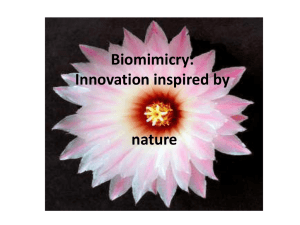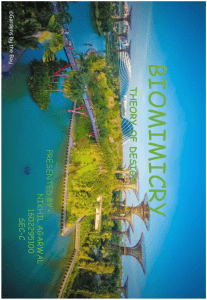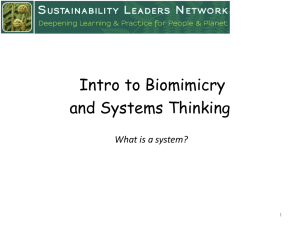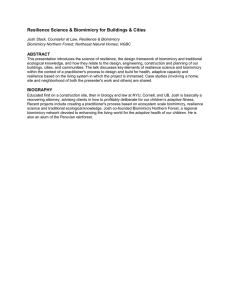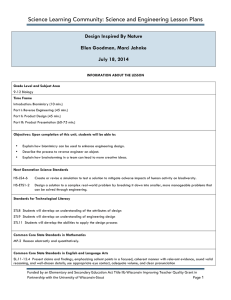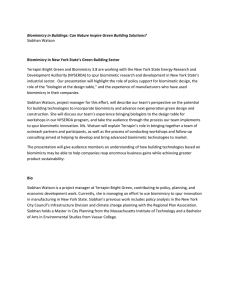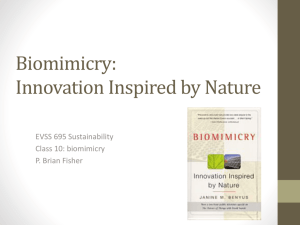Nature Did It First Activity Kit: Biomimicry STEM Challenges
advertisement
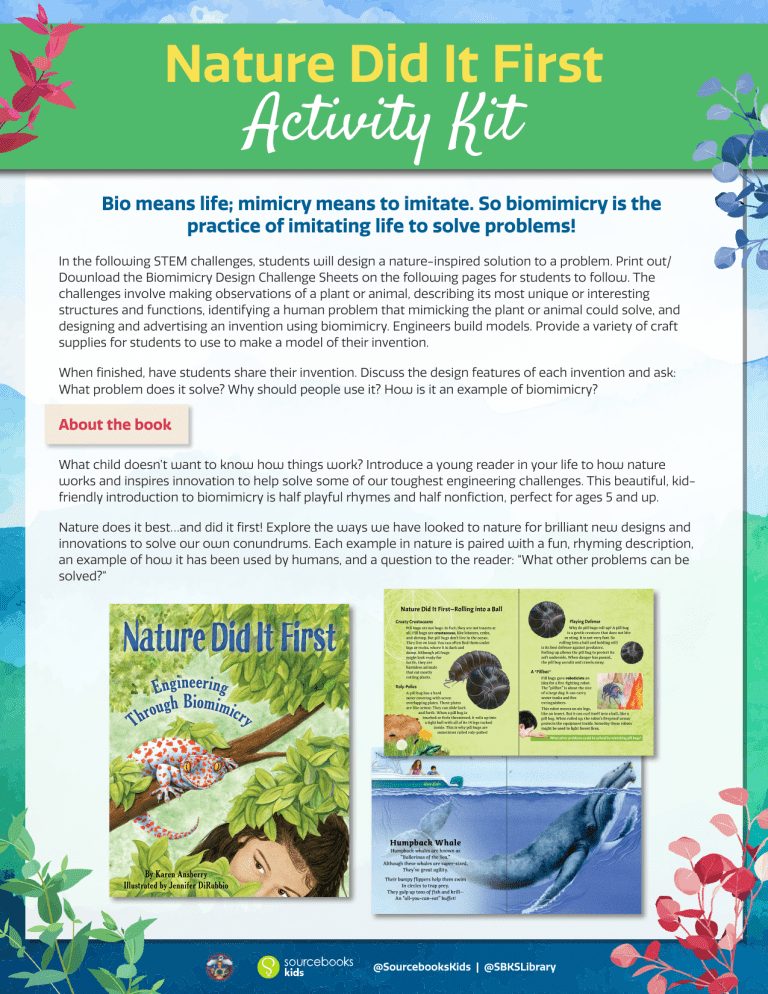
Nature Did It First Activity Kit Bio means life; mimicry means to imitate. So biomimicry is the practice of imitating life to solve problems! In the following STEM challenges, students will design a nature-inspired solution to a problem. Print out/ Download the Biomimicry Design Challenge Sheets on the following pages for students to follow. The challenges involve making observations of a plant or animal, describing its most unique or interesting structures and functions, identifying a human problem that mimicking the plant or animal could solve, and designing and advertising an invention using biomimicry. Engineers build models. Provide a variety of craft supplies for students to use to make a model of their invention. When finished, have students share their invention. Discuss the design features of each invention and ask: What problem does it solve? Why should people use it? How is it an example of biomimicry? About the book What child doesn’t want to know how things work? Introduce a young reader in your life to how nature works and inspires innovation to help solve some of our toughest engineering challenges. This beautiful, kidfriendly introduction to biomimicry is half playful rhymes and half nonfiction, perfect for ages 5 and up. Nature does it best…and did it first! Explore the ways we have looked to nature for brilliant new designs and innovations to solve our own conundrums. Each example in nature is paired with a fun, rhyming description, an example of how it has been used by humans, and a question to the reader: “What other problems can be solved?” @SourcebooksKids | @SBKSLibrary Nature Did It First features fascinating examples of biomimicry, like: • How burrs inspired Velcro • How grooved gecko feet inspired adhesive • How bumpy whale flippers inspired windmill blades and surfboards • And more! Back matter includes: • A glossary for words like echolocation and adhesive • STEM Challenge activity perfect for your home or classroom Praise for the Book “Inspiring for all those kids who look at the world in wonder and ask, what if?” —Kirkus Reviews “A delightful introduction to biomimicry for young readers.” —Gretchen Hooker, Biomimicry Institute Program Manager “Wonderful and informative.” —Dr. Christine Anne Royce, Column Author for Teaching Through Trade Books, Science and Children; 2018–2019 NSTA President About the Author and Illustrator Karen Ansberry has been a Mason City (Ohio) Schools elementary science curriculum leader since 1998; from 1991 to 1998 she was a classroom teacher and science curriculum coordinator for grades 5 and 6. She has a bachelor’s degree in biology from Xavier University and a master’s in teaching from Miami University in Ohio. Jennifer DiRubbio is both a passionate artist and an avid environmentalist. She has been active as an artist for several organizations that promote nature and a healthy planet. Jennifer graduated with a BFA from Pratt Institute in 1992. She keeps her home and studio in Merrick, New York, as “green” and environmentally sound as possible, where her husband and two young children also work and play. @SourcebooksKids | @SBKSLibrary Biomimicry Design Challenge Name: Bio means life; mimicry means to imitate. So biomimicry is the practice of imitating life to solve problems. For this STEM challenge, you will design a nature-inspired solution to a problem. STEP 1: Study Nature Observe one of your favorite plants or animals up close (or by using books or Internet resources). What unique or interesting structures does it have that help it function, or survive in its environment? Structure (Part) Function (Purpose) STEP 2: Identify a Problem Think about the plant or animal and its unique structures and functions. What human problem might the plant or animal help solve? How? @SourcebooksKids | @SBKSLibrary Biomimicry Design Challenge Name: STEP 3: Brainstorm and Design What could you invent that would imitate the plant or animal in order to solve the problem? Think about a tool, toy, article of clothing, robot, or other technology that could be designed to mimic the plant or animal. Sketch your invention below. STEP 4: Build a Model Experiment with simple materials you could use to build a model of your invention, then build it! List the materials you used below: @SourcebooksKids | @SBKSLibrary Biomimicry Design Challenge Name: STEP 5: Share Your Solution Make an advertisement to “pitch” your invention. Give it a catchy name. Describe how it solves a problem and why people should use it. Tell how the invention is an example of biomimicry. @SourcebooksKids | @SBKSLibrary Biomimicry Design Challenge Name: Got a problem? Nature has a solution! Invent something that solves a problem using nature as your inspiration. Draw it in the space below. Name of Invention: What problem does your invention solve? What plant or animal inspired your invention? @SourcebooksKids | @SBKSLibrary Biomimicry Design Challenge Student Glossary 1. Adhesive: a substance used for sticking objects or materials together. 2. Biomimicry: the process of designing nature-inspired solutions to problems. 3. Carnivorous: (of animals) flesh-eating; (of plants) able to trap and digest insects and other small animals. 4. Crustacean: a type of animal, typically living in water, with a segmented body, a hard outer shell, and several pairs of legs. 5. Echolocation: the use of reflected sound waves (echoes) to locate objects. 6. Engineer: a person trained and skilled in using science and math to design or invent things. 7. Roboticist: a person who specializes in designing, building, and programming robots. 8. Streamlined: having a shape that makes movement easier through air or water. 9. Technology: a tool or machine designed to help solve a problem or meet a need. 10. Vibration: a rapid back-and-forth movement. @SourcebooksKids | @SBKSLibrary
